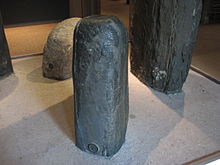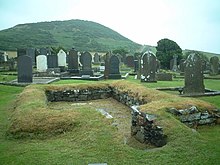Isle of Man ogham and rune stones
The Isle of Man's Ogham and rune stones are a heterogeneous group of six stones that originated between the 5th and 12th centuries. Example of the amalgamation of Irish ( Déisi ) and Nordic cultures on the Isle of Man ( Vikings - Kingdom of the Islands from the 9th to the 13th centuries) are two stones that combine runes and Ogham inscriptions on the same stone.
The Ogham rune stones
The Maughold Stone and the Kirk-Michael Stone are still in situ , while the remaining Ogham stones are in the Douglas Museum.
Kirk-Michael-Stein
The Kirk Michael Stone is a cross plate decorated in the 11th century with a long runic inscription in bound Ogham symbols in memory of a foster son. There are faintly recognizable Ogham writings on the front and back of the plate. The inscription on the front covers the entire Ogham alphabet, the one on the back is no longer legible. These two inscriptions are not part of the cross plate but scratched it in the 11th or 12th century.
᚛ᚁᚂᚃᚄᚅᚆᚇᚈᚉᚊᚋᚌᚍᚎᚏᚐᚑᚒᚓᚔ᚜ ᚛ᚋᚒᚒᚉᚑᚋᚐᚂᚂᚐᚃᚔᚒᚐᚋᚒᚂᚂᚌᚒᚉ᚜ ᛘᛅᛚ᛬ᛚᚢᛘᚴᚢᚿ᛬ᚱᛅᛁᛋᛏᛁ᛬ᚴᚱᚢᛋ᛬ᚦᛁᚾᛅ᛬ᛁᚠᛏᛁᚱ᛬ᛘᛅᛚ᛬ᛘᚢᚱᚢ᛬ᚠᚢᛋᛏᚱᛅ᛬ᛋᛁᚾᛁ᛬ᛏᚭᛏᛁᚱᛏᚢᚠᚴᛅᛚᛋ᛬ᚴᚭᚾᛅ᛬ᛁᛋ᛬ᛅᚦᛁᛋᛚ᛬ᛅᛏᛁ᛭ ᛒᛁᛏᚱᛅᛁᛋ᛬ᛚᛅᛁᚠᛅ᛬ᚠᚢᛋᛏᚱᛅ᛬ᚴᚢᚦᛅᚾ᛬ᚦᛅᚾ᛬ᛋᚭᚾ᛬ᛁᛚᛅᚾ᛭
It is believed that the Kirk-Michael stone and the Maughold stone were deliberately damaged by the addition of the Ogham alphabet. A Gaelic reaction against the occupiers is seen as the reason. On the other hand, however, at least with the Maughold stone , the scientific community comes to the conclusion that the incision of the Ogham characters must have been carried out well before the incision of the runic characters.
Older tombstones
In contrast to the very late Ogham runic inscriptions, there are some typical Irish stones to commemorate people with Gaelic names that date back to the 5th or 6th century:
- Bimaken Friary Stone I.
- Ballaqueeney Stone I.
- Ballaqueeney Stone II
Two of these three stones were found in the cemetery of a keeill (the word "chapel" in Manx , Irish: cill), a small, early medieval (8th to 12th century) Celtic chapel. About 200 such keeills were scattered across the island and 35 have been preserved. The ogham stones associated with Keeills were likely tombstones.
The Knoc-y-Doonee stone, another early stone that also came from a keeill burial ground, has an Ogham Latin inscription:
- Here lies Ammecatus, son of Rocatus (in Latin)
- Ambicatos, son of Rocatos (in Ogham)
The memory of a person in Latin and Ogham inscriptions is typical of the Ogham stones in Wales (e.g. Nevern Churchyard ) and Cornwall , but completely unknown on Irish Ogham stones. The name Rocatos is likely Gaelic, but his son has a Britonized name. Ammecatus or Ambicatos is the equivalent of the Irish Imbicatos. Thus, this stone, probably from the 6th century, proves an early British influence on the Irish Manx culture.
The Speke Farm Keeill stone, discovered in 2007 in the burial ground of a keeill from the 11th century, is one of the most unusual and important Ogham stones found on the island.
The "Bimaken Friary Stone II" is less typical. It has a strangely oval shape and is therefore very different from the stone pillars on which Ogham was usually inscribed. The stone uses the late linguistic form "maq" for the earlier "Maqi". This originated between the 6th and 9th centuries.
See also
literature
- Damien McManus: A Guide to Ogam. To Sagart, Maynooth 1991, ISBN 1-870684-17-6 .
- Charles Thomas: And Shall These Mute Stones Speak? University of Wales Press, Cardiff 1994, ISBN 0-7083-1160-1 .
- Sabine Ziegler: The language of the old Irish Ogam inscriptions. Vandenhoeck & Ruprecht, Göttingen 1994, ISBN 3-525-26225-6 .
Remarks
- ↑ Ogham symbols, in which the ends of the branches to the left and right of the stem line are connected to each other within each letter
- ^ In contrast to this, the British sinologist Andrew Christopher West (* 1960) on his website The Ogham Stones of the Isle of Man .
Web links
- Illustrations with descriptions of all the Isle of Man ogham stones - in English



